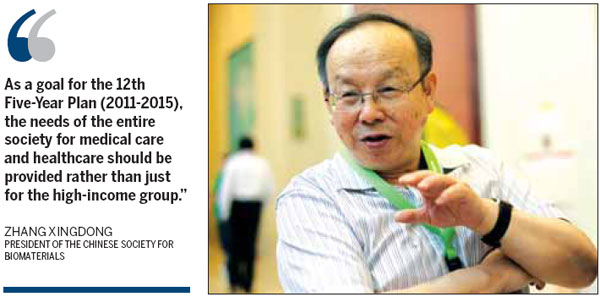
China's biomaterials industry is expected to register a sharp growth in the next few years with revenues projected to rise as high as $40 billion by 2015, Zhang Xingdong, president of the Chinese Society for Biomaterials, said during the World Biomaterials Congress that began on June 1 in Chengdu, Sichuan province.
The figure is estimated to surpass $100 billion by 2020, he added.
The most important global meeting in the biomaterials industry held only once every four years, this year's congress focuses on new materials used in the field and regenerative medicine.
The young, fast-growing sector has a close connection to medical care and crosses frontiers to include new materials, cell engineering, modular biology and clinical treatment.
Zhang, also member of the Chinese Academy of Engineering, is himself a pioneer research scientist who uses tissue-inducing biomaterials to fix injured bones and teeth.

"Like a machine, tissues or organs will wear out over time and need to be fixed," he said. "We are researching the repair materials."
Made from a diverse range of materials including ceramics, metals, polymers and composites, so-called tissue-inducing biomaterials can integrate into the human body. It is the design of the materials themselves, not conventional tissue growth, which brings improvement in heath and well being, experts said.
The biomaterials industry is low energy intensive, high value and helps improve the quality of life, Zhang said, noting that clinical demand is driving its growth.
Despite the sluggish global economy, the emerging high-tech sector has maintained 7 percent average annual growth, he noted.
The industry generated $150 billion in global sales in 2010, a marked surge from $20 billion in 2000.
China accounted for about 6 percent of that global total, or $10 billion in yearly sales, a small share that does not match its level of study and research, according to Zhang.
"We are at the forefront globally in research in the field with related academic essays ranking at the top of the world," he said. "Otherwise, the congress wouldn't take place here."
It is the industrialization of research in China that lags far behind due to the shortage of investors, he noted.
"The industry has yet to achieve economies of scale in production and broaden investment or financing channels," he said.
The academic called on domestic companies to improve their capacity for innovation and develop high-end biomaterials.
He cited the example of a vascular stent, which before cost 30,000 yuan ($4,709) to 40,000 yuan because 90 percent of it was made from imported materials.
Now some 75 percent of the product can be locally made, bringing the price down to around 10,000 yuan, which makes it affordable to more people.
"As a goal for the 12th Five-Year Plan (2011-2015), the needs of the entire society for medical care and healthcare should be provided rather than just for the high-income group," he said.
wangxin@chinadaily.com.cn







